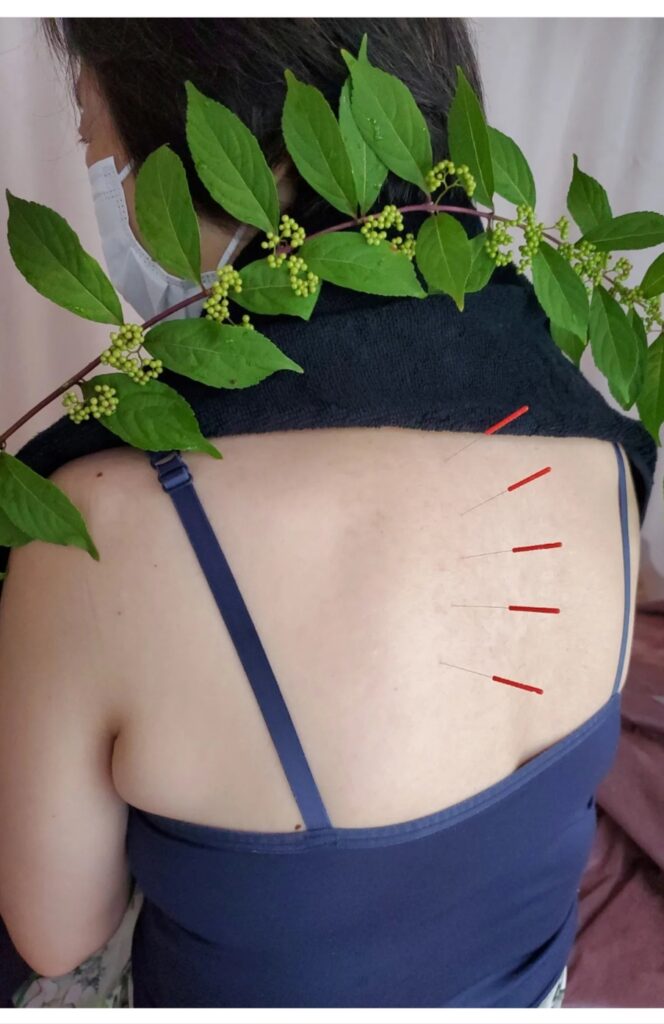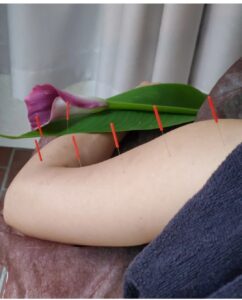肩甲骨のコリ
stiffness in the shoulder blades
肩甲骨のコリを感じる人は、肩甲骨だけでなく、首、肩、背中にかけての広い範囲が硬くなってしまったり、重く感じたり、痛んだりといった随伴症状を伴う人も多いです。肩甲骨の痛みや不快感は、猫背などのもともとの体型や、前かがみの姿勢を続けることなどによって、筋肉が緊張して血行が悪くなることで生じることがあります。新型コロナで、パソコン前に座ることが多くなり、長時間のデスクワークなどの影響で、筋肉がさらにこわばって血行不良が進み、症状を強く感じることもあります。パソコンでの作業やスマートフォンの操作などで前傾姿勢をとり続けることで、頚椎のカーブがまっすぐになったり(ストレートネック)も、肩甲骨のコリを発症させます。人間は、5 kgほどもある頭の重さを支えるために首の筋肉に大きな負担がかかっています。首の筋肉は、肩甲骨にも関係しています。肩甲骨は肋骨の背中側の上にあり、島のように浮いた構造をしていて、肋骨の上をすべるように動くようにできています。しかし、長時間じっとして前傾姿勢を続けることが多くなった場合、肩甲骨が外側に広がったままで動かないため、肩甲骨周辺の筋肉の血行が悪くなって硬くなりやすくなります。そのため余計に肩甲骨の動きも悪くなり、そのまま動かさないと、首も肩もこり固まっていくという悪循環になります。鍼灸治療としては、肩甲骨を上に引き上げる役割をする肩甲挙筋と、肩甲骨を寄せる菱形筋に刺鍼して血行促進をさせて、筋の柔軟性を取り戻し、不快な症状を改善させます。入浴や肩甲骨回しなどのストレッチも肩甲骨周辺をほぐすのでお勧めです
Many people who experience stiffness in the shoulder blades have accompanying symptoms such as stiffness, heaviness, or pain not only in the shoulder blades, but also in a wide area of the neck, shoulders, and back. Pain and discomfort in the shoulder blades can be caused by an original body shape, such as a stooped back, or by continued stooping, which causes muscle tension and poor blood circulation. With the new Corona, people often sit in front of a computer and work at a desk for long hours, which further stiffens the muscles and causes poor blood circulation, and symptoms may be felt more intensely. Straightening of the curve of the cervical vertebrae (straight neck) due to continuous leaning forward while working on a computer or operating a smartphone can also cause stiffness in the shoulder blades. The neck muscles bear a heavy burden in order to support the weight of the head, which can weigh as much as 5 kg. Neck muscles are also related to the shoulder blades. The scapula is located on the back side of the ribs and has a floating, island-like structure that allows it to glide over the ribs. However, if the patient sits still and leans forward for long periods of time, the shoulder blades remain spread outward and do not move, and the muscles around the shoulder blades tend to become stiff due to poor blood circulation. This leads to poor movement of the shoulder blades, and if the shoulder blades are not moved, the neck and shoulders become stiff and hardened, creating a vicious cycle. Acupuncture and moxibustion treatment involves acupuncture in the levator scapulae muscle, which pulls the shoulder blades upward, and in the rhomboid muscle, which pulls the shoulder blades together, to promote blood circulation, restore muscle flexibility, and improve discomfort symptoms. Bathing and stretching such as shoulder blade rotations are also recommended to relax the shoulder blade area.



